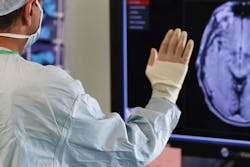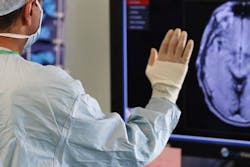Microsoft Kinect-based technology for vascular surgery now being extended to neurosurgery
Researchers from the School of Computing and Communications at Lancaster University in England were part of a collaborative team from Microsoft Research (Cambridge, England), Guy's Hospital, St Thomas' NHS Foundation Trust, and King's College London (all in London, England) that developed a "touchless" Microsoft Kinect sensor-based technology for vascular surgery, which has been tested in the operating theatre and is now being explored for neurosurgery. The work explores the use of touchless interaction within surgical settings, enabling surgeons to view, control, and manipulate medical images without contact.
Related: 3D digital holograms visualize biomedical applications
Following the successful pilot of the technology in vascular surgery procedures, the team from Lancaster and Microsoft has partnered with neurosurgeons at Addenbrooke's NHS Foundation Trust and Cambridge University (both in Cambridge, England) to apply the technology—dubbed "Touchless Interaction"—to the manipulation of 3D volumetric models of the brain for neurosurgery. The new system is currently being piloted in operating theatres.
Surgeons operate in a challenging environment where they are required to maintain sterility at all times. Re-scrubbing is time-consuming; therefore, surgeons are frequently compelled to instruct others to manipulate visual-aid equipment for them, which is often an impractical and imprecise method.
The new gesture recognition-based systems utilize Kinect for Windows hardware and the Kinect for Windows Software Development Kit to allow the surgery teams to maintain a sterile environment with the ability to view and manipulate medical images through a combination of gesture and voice control.
"Adapting the technology for neurosurgery has allowed us to understand how the system works across different surgical domains," explains Prof. Kenton O’Hara of Microsoft Research. "As well as refining the gesture set, the new system incorporates enhanced voice control that enables the surgeon to control the system using only voice, leaving both hands free to work with surgical instruments."
The touchless interaction software was developed by Gerardo Gonzalez, a postdoctoral researcher at Microsoft Research from Lancaster University.
For more information, please visit http://research.microsoft.com/apps/video/default.aspx?id=174856.
-----
Don't miss Strategies in Biophotonics, a conference and exhibition dedicated to development and commercialization of bio-optics and biophotonics technologies!
Follow us on Twitter, 'like' us on Facebook, and join our group on LinkedIn
Subscribe now to BioOptics World magazine; it's free!


